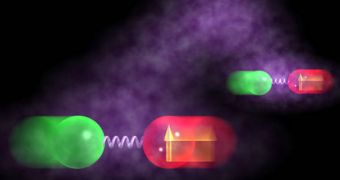Researchers at the National Institute of Standards and Technology (NIST) in Boulder, Colorado, have just recently managed to devise the first quantum device, despite the fact that quantum physics and related theories have been around for a while. Thus far, no one succeeded in creating a machine that would actually make use of the quirks of this type of physics, but the gadget created at NIST comprises only two pairs of ions (charged atoms), oscillating in an electrical field in a manner resembling two marbles joined together by a spring.
This type of link is known in the physics community as entanglement, and has been until now only observed in scales smaller than the atomic one. The inner gyrations of ions were assessed using this technique, but this is the first time the movements of the ions themselves can be created and controlled using it. “For the first time, the mechanical motion itself has been entangled,” Experimental Physicist Rainer Blatt, from the University of Innsbruck in Austria, says.
As their mechanical widgets, the NIST team used beryllium-magnesium pairs, but creating them proved to be a real challenge to begin with. They trapped two beryllium and two magnesium ions employing high-energy electric fields, and then made use of magnetic fields and pulses of laser to separate the pairs into their components, ScienceNow reports. After that, when the spin of the beryllium ions was entangled, they separated them into the two widgets they used for the experiments.
Reporting in the latest edition of the journal Nature, the researchers share that they managed to make the pairs exist in an oscillating and a non-oscillating state at the same time. And this is the basic definition of a quantum device. The success may open up new avenues of research in the field of quantum computers, which are believed to be able to crack codes that conventional processors would take decades or centuries to break. However, they say that there's still a long way to go before such a machine will be created.
“It's a completely amazing experiment. It's more the macroscopic than the mechanical that we're after,” Yale University Physicist Jack Harris adds. “A lot of the technologies we developed for this experiment are going to be crucial for making a quantum computer with trapped ions,” NIST expert John Jost tells.

 14 DAY TRIAL //
14 DAY TRIAL //